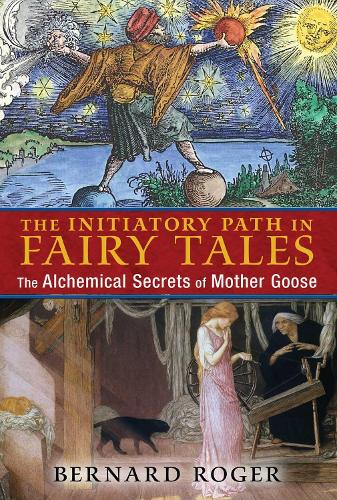
The Initiatory Path in Fairy Tales: The Alchemical Secrets of Mother Goose
(Paperback)
Publishing Details
The Initiatory Path in Fairy Tales: The Alchemical Secrets of Mother Goose
By (Author) Bernard Roger
Inner Traditions Bear and Company
Inner Traditions Bear and Company
21st June 2015
United States
Classifications
General
Non Fiction
Folklore studies / Study of myth
398.2
Physical Properties
Paperback
320
Width 152mm, Height 229mm, Spine 18mm
531g
Description
In his Mystery of the Cathedrals, the great alchemist Fulcanelli revealed the teachings of the hermetic art encoded in the sculpture and stained glass of the great cathedrals of Europe. What he did for churches, his disciple Bernard Roger does here for fairy tales.
Through exhaustive analysis of the stories collected by the Brothers Grimm, Perrault, and others, Roger demonstrates how hermetic ideas, especially those embodied in alchemy and Freemasonry, can be found in fairy tales, including such popular stories as Cinderella, Snow White, Sleeping Beauty, and Little Red Riding Hood as well as the tales attributed to "Mother Goose." The goose has long been an important esoteric symbol in the Western Mystery tradition. The stories told under the aegis of Mother Goose carry these symbols and secrets, concealed in what hermetic adepts have long called "the language of the birds."
Drawing upon the original versions of fairy tales, not the sanitized accounts made into children's movies, the author reveals how the tales illustrate each stage of the Great Work and the alchemical iterations required to achieve them. He shows how the common motif of a hero or heroine sent in search of a rare object by a sovereign before their wishes can be granted is analogous to the Masonic quest for the lost tomb of Hiram or the alchemist's search for the fire needed to perform the Great Work. He also reveals how the hero is always aided by a green bird, which embodies the hermetic understanding of the seed and the fruit.
Roger demonstrates the truly ancient lineage of these initiatory stories and how they originated as the trigger to push humanity toward higher levels of consciousness.
Reviews
Etymology, mythology, and esoteric thought converge in a fascinating journey through the worlds of tall tales we tell in jest, yarns we spin for laughs, and fairy tales we weave to put the kids to bed. Indeed, Rogers book shows that what we think of as a hidden path to enlightenment is in fact written into the very fabric of our daily lives, in every story we tell ourselves. What we are shown is that these tales of fancy have within them the kernel of truths humanity has known for thousands of years. The book knits together a compelling genealogy that links our stories, our hopes, and our dreams. A compelling read for the novice and initiate alike. * Jesse Bransford, associate professor of art and art education, NYU Steinhardt *
Bernard Roger was a close friend of surrealist leader Andr Breton, the esoteric painter Jorge Camacho, and of Eugne Canseliet, the disciple of Fulcanelli, the most important alchemist of the twentieth century. Roger, familiar with the mysteries of alchemy and Freemasonry, is obviously one of the most qualified to help us penetrate the heart of the Western Tradition. His book takes us to the threshold of the labyrinth and unveils the secrets of Mother Goose, an avatar of the sun, freshly emerged from her primordial egg, and a messenger between the Earth and the Other World. * Patrick Lepetit, author of The Esoteric Secrets of Surrealism *
"The Initiatory Path in Fairy Tales: The Alchemical Secrets of Mother Goose by Bernard Roger A truly phenomenal book. A favorite!" * Director Guillermo del Toro, screenwriter, producer and director of Blade II, Hellboy and Mimic *
"Classic as well as little-known fairy tales are ripe with hermetic teachings of alchemy and Freemasonry. In this book, The Initiatory Path in Fairy Tales: the Alchemical Secrets of Mother Goose, Bernard Roger, provides an exhaustive analysis to prove his point and deliver what the title promises. To understand and appreciate this book, you must be very interested in the teachings and practices of the Freemasonry society, induction and alchemy, and have a basic knowledge of the concepts and practices. I was not prepared. Also, many examples Roger sites are from fairy tales I never heard of, and the pages are so thick with details, I sometimes found myself skimming. There is still valuable knowledge for the beginner, such as how quests generally have happy outcomes as the seeker learns its the princess and not the jewel, bird, key, flower or fruit that is meant to be found, and that these quests correspond to alchemy practices. The six chapters cover the tales, the initiation, the stages, the door to the temple or V.I.T.R.I.O.L., the paths of V.I.T.R.I.O.L. and the ultimate success. There are sections on the forest, the castle, riddles, impossible tasks and fighting dragons. Readers will learn the four essential factors of fate (the cause of the quest, assistants offered to him along the way, the object of the quest, and the place where it is found), the ritual for the 18th degree of Scottish Freemasonry and much more in-between." * Lynn Woike, PaganPages.org *
Author Bio
Bernard Roger is the last of the generation of alchemists who worked directly with Eugene Canseliet, Rene Alleau, and other disciples of Fulcanelli. A member of the surrealist group in France, he is the author of A la Dcouverte dalchimie and Paris et lAlchimie. He lives in Paris.
